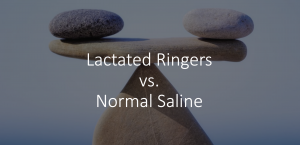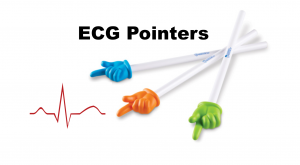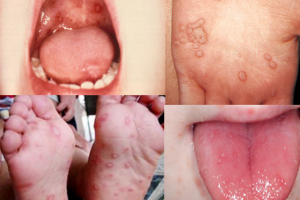Today on the emDOCs cast with Brit Long, MD (@long_brit), we cover part 1 on upper GI bleeding, specifically some background, NG tube lavage, blood product transfusion, proton pump inhibitors (PPIs), prokinetic agents, somatostatin analogues, and antibiotics.
Episode 125: Upper GI Bleeding Evidence and Controversies Part 1
Introduction:
- Acute upper gastrointestinal bleeding (UGIB): bleeding from above the ligament of Treitz (i.e., esophagus, stomach, proximal small intestine) .
- Common reason for presentation to the ED. UGIB has an incidence of 48-160 per 100,000 persons; over 250,000 admissions annually.
- UGIB more common than lower GI bleeding; accounts for approximately 75% of all acute GI bleeding patients.
- UGIB is associated with a sixfold increased rate of admission and higher mortality (2-15%) compared to lower GI bleeding.
- Men affected more commonly than women.
Etiologies:
- Esophagitis, esophageal varices, peptic ulcer disease, gastritis, duodenitis, Mallory-Weiss tear, and vascular malformations.
- Bleeding from a peptic ulcer is most common overall (40-50%), but bleeding in those with esophageal varices is associated with significant morbidity and mortality.
- Multiple risk factors for developing a new UGIB: prior UGIB, anticoagulant use, nonsteroidal anti-inflammatory drug (NSAID) use, older age, Helicobacter pylori infection, and renal disease.
Presentation:
- Spectrum of symptoms: range from mild hematemesis to syncope, shock, and airway compromise with severe hemorrhage.
- Hematemesis with fresh blood or clots is highly suggestive of moderate to severe bleeding.
- Melena, coffee-ground emesis, or hematochezia may occur in severe UGIB.
Is nasogastric tube lavage recommended to determine the source of bleeding?
- Nasogastric tube (NGT) lavage previously used to assist in differentiating UGIB versus LGIB.
- NGT lavage with red blood or coffee ground appearing material may confirm UGIB; may also suggest continued bleeding.
- Problem: NGT lavage can be negative if there is no continued bleeding or if the source of bleeding is distal to the pylorus. Associated with significant discomfort and risk of epistaxis and placement failure.
- More recent data suggest NGT lavage does not assist in differentiating UGIB versus LGIB.
- An RCT found NGT lavage was not associated with improved prediction of a high risk lesion needing endoscopic management.
- Studies do not show benefit in patient-centered outcomes, including difference in mortality, hospital length of stay (LOS), need for surgery, or transfusion, but there may be a shorter time to endoscopy.
- Take-home: NGT lavage should not be used routinely to determine a bleeding source; may use it to aspirate material from the stomach to assist with endoscopy and if needing to intubate.
When should blood products be administered?
- First: for massive hemorrhage and hemodynamic instability, start blood product transfusion with whole blood (if available), followed by transfusion of packed red blood cells (pRBCs), platelets, and fresh frozen plasma (FFP) in a 1:1:1 ratio.
- Massive transfusion protocol may be necessary; also administer calcium.
- In stable patients, use a conservative hemoglobin transfusion threshold of 7 g/dL. Use ≥ 8 g/dL in those with existing cardiovascular disease.
- This transfusion threshold is recommended by the American College of Gastroenterology (ACG), the European Society of Gastrointestinal Endoscopy (ESGE), and the Association for the Advancement of Blood and Biotherapies.
- Guidelines and recommendations based on several RCTs and systematic reviews.
- 2013 RCT including patients with GI bleeding compared 7 g/dL and 9 g/dL hemoglobin transfusion thresholds but excluded those with massive hemorrhage. Reduced transfusion (49% vs. 86%) and lower mortality (5% vs. 9%) in7 g/dL transfusion threshold group. Also reduced bleeding (10% vs. 16%), fewer cardiac complications (11% vs. 16%), and fewer transfusion reactions (3% vs. 9%).
- Meta-analysis with 1,965 patients found reduced transfusion (mean difference -1.73 units), all-cause mortality (relative risk 0.65), and rebleeding (relative risk 0.58) using restrictive transfusion threshold in both variceal and non-variceal UGIB.
- 2021 meta-analysis evaluating transfusion thresholds for all types of bleeding (GI, surgery, critical care) found no difference in 30-day mortality with restrictive transfusion strategy compared to a liberal transfusion strategy (risk ratio 0.99, 95% confidence interval [CI] 0.86-1.15), but there were fewer pRBC transfusions in the restrictive transfusion strategy.
- Avoid over resuscitation (especially cirrhosis and suspected variceal bleeding). Base transfusion in these patients on baseline blood pressures and markers of perfusion (e.g., mental status, capillary refill, heart rate).
- Administer platelets severe bleeding or critical illness and platelet count < 50,000 cells/mm3; platelet transfusion not recommended as a reversal option for those on antiplatelet agents.
- In anticoagulated patients (e.g., warfarin, direct oral anticoagulants [DOACs]), reverse if severe bleeding: for warfarin -> vitamin K and prothrombin complex concentrates (PCC) or FFP; for DOACs -> PCC or a DOAC-specific reversal agent.
- Data suggest that endoscopy is likely safe for patients with thrombocytopenia. ACG, ESGE, and International Consensus Group (ICG) recommend not delaying endoscopy for reversal of anticoagulation.
- Antifibrinolytics include TXA. The 2020 HALT-IT trial included over 12,000 patients with UGIB. No reduction in death due to bleeding within 5 days (risk ratio 0.99, 95% CI 0.82-1.18) with TXA, but TXA was associated with increased VTE (risk ratio 1.85, 95% CI 1.15-2.98) and seizures (1.73, 95% CI 1.03-2.93).
- Based on the available evidence, the ACG and ESGE recommend against using TXA in those with UGIB.
- Take-home: Resuscitate with blood products if unstable, but otherwise use Hg transfusion threshold 7 g/dL (8 for cardiovascular disease). Reverse anticoagulation for severe bleeding. TXA does not show benefit in patient-oriented outcomes.
What medications should we be thinking about in the ED setting?
Proton Pump Inhibitors
- In UGIB due to peptic ulcer disease, PPIs may neutralize gastric acid and stabilize blood clots. They may also reduce the prevalence of endoscopic bleeding stigmata.
- Evidence for PPIs in all patients with UGIB is controversial; no improvement in patient-oriented outcomes.
- Cochrane review of 21 RCTs including patients with endoscopically confirmed peptic ulcer bleeding found PPI therapy reduced rebleeding (NNT 15), surgical intervention (NNT 32), and repeat endoscopy (NNT), with no reduction in mortality overall.
- Cochrane review of 6 RCTs including undifferentiated UGIB and evaluated PPIs, H2-receptor antagonists, or no treatment prior to endoscopy. No reduction in mortality, risk of rebleeding, or need for surgery. Reduction in secondary outcomes including stigmata of recent hemorrhage (odds ratio [OR] 0.67, 95% CI 0.54-0.84, NNT 11) with PPI compared to control and reduced need for endoscopic therapy at the index visit (OR 0.68, 95% CI 0.50-0.93, NNT 33).
- PPIs include pantoprazole or omeprazole. Dosing is 80 mg intravenous (IV) bolus followed by 8 mg/hour or pantoprazole or omeprazole 40-80 mg IV twice per day. Evidence suggests no difference in outcomes between dosing regimens.
- 2013 Cochrane review with 22 RCTs evaluated high-dose bolus PPI therapy with continuous infusion compared to lower doses administered by continuous infusion, IV bolus, or orally after endoscopy for peptic ulcer bleeding. No difference in mortality, rebleeding, surgery, hospital LOS, or blood transfusion.
- 2014 meta-analysis including 13 studies comparing continuous infusion PPI versus intermittent dosing in those with UGIB from high-risk peptic ulcer after endoscopy. Intermittent dosing was noninferior in rebleeding in 7-30 days, mortality, need for intervention, need for blood transfusion, or hospital LOS.
- Guidelines:
- ACG does not make a recommendation for or against pre-endoscopic PPI therapy due to the lack of improvement in patient-oriented outcomes, but post-endoscopic PPIs may reduce risk of rebleeding in those with confirmed peptic ulcers and high risk of bleeding. Thus, the ACG states that PPI therapy may have a benefit in a minority of patients with UGIB due to peptic ulcer disease and that a PPI may be given based on indirect evidence. PPI may be considered in patients who will not undergo endoscopy or in whom endoscopy will be delayed.
- The ESGE suggests that high-dose PPI administration in UGIB may be considered to reduce risk of bleeding stigmata and need for endoscopic therapy despite the absence of improvement in patient-oriented outcomes. Recommend high dose PPI therapy for patients who receive endoscopic hemostasis.
- Take-home: PPIs may assist in those with confirmed peptic ulcer disease after endoscopy by reducing rebleeding and need for surgical intervention or repeat endoscopy. They are not associated with associated with improved outcomes in other patients with UGIB. If PPI administered, use pantoprazole or omeprazole 40-80 mg IV every 12 hours (versus 80 mg IV bolus and 8 mg/hr IV infusion). Frees an IV line.
- H2-receptor antagonists do not demonstrate efficacy in acute UGIB and are not currently recommended.
Prokinetic Agents
- Prokinetic agents (e.g., erythromycin, metoclopramide) promote gastric emptying and clear the stomach of blood and clots. May improve endoscopic visualization and diagnostic yield.
- 2016 meta-analysis with 8 RCTs evaluated erythromycin prior to endoscopy in those with UGIB. Erythromycin improved visualization (OR 4.14, 95% CI 2.01-8.53, NNT 4), reduced the need for second endoscopy (OR 0.51, 95% CI 0.34-0.77, NNT 9), and reduced the hospital LOS (-1.75 days; 95% CI -2.43 to -1.06) (55). No difference in need for emergent surgery or amount of blood transfused.
- 2023 Cochrane review including 11 RCTs found improved visualization in patients receiving erythromycin (mean difference 3.63 points on 16-point ordinal scale, 95% CI 2.20-5.05), but no difference in non-serious and serious adverse events, all-cause mortality, and rebleeding.
- Guidelines: ACG guidelines suggest administering erythromycin prior to endoscopy; ESGE guidelines recommend erythromycin only in those with clinically severe or continued, active UGIB prior to endoscopy.
- Older studies have not found a definitive benefit with metoclopramide 10-20 mg IV; ACG does not currently recommend its use to improve visualization prior to endoscopy.
- 2019 study of 52 patients found improved fundal visualization with metoclopramide in non-ulcer cases of UGIB.
- RCT of 68 patients comparing metoclopramide versus placebo found metoclopramide was associated with improved rates of adequate visualization (OR 13, 95% CI 1.32-128.10) and endoscopic visualized gastroduodenal scores and reduced need for second look endoscopy (OR 0.11, 95% CI 0.01-0.99) (58). ).
- Take-home: Prokinetic agents may assist in gastric emptying and improve the diagnostic and therapeutic capabilities of endoscopy. They are not recommended routinely in all patients with UGIB.
- Dosing: Erythromycin 250 mg IV over 5-30 minutes or metoclopramide 10-20 mg IV with endoscopy 20-90 minutes following the infusion.
Somatostatin Analogues
- Somatostatin analogues reduce splanchnic blood flow and portal pressures. Octreotide is most commonly available in the U.S. and is commonly used for variceal UGIB.
- Cochrane review including 21 RCTs of patients with UGIB from esophageal varices found no reduction in all-cause mortality or risk of rebleeding, but there was a reduction in the amount of blood products transfused by 0.7 units.
- No benefit in patients with UGIB from other causes.
- Take-home: Octreotide is not universally recommended for all patients with UGIB. Consider it it in situations where the patient is hemodynamically unstable or if endoscopy is not available, specifically in variceal UGIB.
- Dosing: 50 microgram IV bolus followed by an infusion of 50 micrograms per hour.
Antibiotics
- IV antibiotics should be used in a select subset of patients with UGIB.
- Cochrane review of 12 studies (1,241 patients) of patients with cirrhosis and UGIB found improved survival and significant reduction in infections such as nosocomial bacteremia, pneumonia, spontaneous bacterial peritonitis, and urinary tract infection.
- NNT 22 for reduced mortality and NNT 4 to prevent infection.
- More critically ill patients demonstrated greatest reduction in mortality with antibiotics. There may also be reduced risk of recurrent bleeding in hospitalized patients with cirrhosis and UGIB from esophageal varices.
- 2025 meta-analysis of 14 studies (1322 participants, 91% with varices) found antibiotics reduced reported infection, but there was not a significant purported mortality benefit. Low quality of evidence overall.
- Take-home: There is controversy regarding antibiotics and upper GI bleeding due to varices. However, consider administering antibiotics such as ceftriaxone 1 g IV in patients with cirrhosis and UGIB.
Summary:
- UGIB is associated with significant morbidity and mortality, with most patients admitted. Hematemesis is the most common presentation, but patients can present with significant hemodynamic changes.
- There are a variety of causes, with peptic ulcer disease the most common.
- NGT lavage is not recommended to confirm the diagnosis.
- Patients with severe bleeding and hemodynamic instability require blood product transfusion. In patients who are stable, a hemoglobin transfusion threshold of 7 g/dL should be used (8 g/dL in those with myocardial ischemia).
- Medications that may be used include PPIs, prokinetic agents, and octreotide. Antibiotics should be administered in those with variceal bleeding.
Stay tuned for Part 2 where we cover endoscopy, other interventions for bleeding cessation, intubation, and risk scores.
References:
- Kamboj AK, Hoversten P, Leggett CL. Upper Gastrointestinal Bleeding: Etiologies and Management. Mayo Clin Proc. 2019 Apr;94(4):697-703.
- Stanley AJ, Laine L. Management of acute upper gastrointestinal bleeding. BMJ. 2019 Mar 25;364:l536.
- Abougergi MS, Travis AC, Saltzman JR. The in-hospital mortality rate for upper GI hemorrhage has decreased over 2 decades in the United States: a nationwide analysis. Gastrointest Endosc. 2015 Apr;81(4):882-8.e1.
- Alali AA, Barkun AN. An update on the management of non-variceal upper gastrointestinal bleeding. Gastroenterol Rep (Oxf). 2023 Mar 20;11:goad011.
- Laine L. Upper gastrointestinal bleeding due to a peptic ulcer. N Engl J Med 2016;375:1198.
- Fouad TR, Abdelsameea E, Abdel-Razek W, et al. Upper gastrointestinal bleeding in Egyptian patients with cirrhosis: Post-therapeutic outcome and prognostic indicators. J Gastroenterol Hepatol. 2019 Sep;34(9):1604-1610.
- Cooper AS. Interventions for Preventing Upper Gastrointestinal Bleeding in People Admitted to Intensive Care Units. Crit Care Nurse. 2019 Apr;39(2):102-103.
- Carbonell N, Pauwels A, Serfaty L, et al. Improved survival after variceal bleeding in patients with cirrhosis over the past two decades. Hepatology. 2004;40(3):652-659.
- Laine L, Barkun AN, Saltzman JR, et al. ACG Clinical Guideline: Upper Gastrointestinal and Ulcer Bleeding. Am J Gastroenterol. 2021 May 1;116(5):899-917.
- Gralnek IM, Stanley AJ, Morris AJ, et al. Endoscopic diagnosis and management of nonvariceal upper gastrointestinal hemorrhage (NVUGIH): European Society of Gastrointestinal Endoscopy (ESGE) Guideline – Update 2021. Endoscopy. 2021 Mar;53(3):300-332.
- Barkun AN, Almadi M, Kuipers EJ, et al. Management of Nonvariceal Upper Gastrointestinal Bleeding: Guideline Recommendations From the International Consensus Group. Ann Intern Med. 2019 Dec 3;171(11):805-822.
- Longstreth GF. Epidemiology of hospitalization for acute upper gastrointestinal hemorrhage: a population-based study. Am J Gastroenterol. 1995 Feb;90(2):206-10.
- Cappell MS, Friedel D. Initial management of acute upper gastrointestinal bleeding: from initial evaluation up to gastrointestinal endoscopy. Med Clin North Am. 2008 May;92(3):491-509, xi.
- Srygley FD, Gerardo CJ, Tran T, Fisher DA. Does this patient have a severe upper gastrointestinal bleed? 2012 Mar 14;307(10):1072-9.
- Lanas A, Perez-Aisa MA, Feu F, et al; Investigators of the Asociación Española de Gastroenterología (AEG). A nationwide study of mortality associated with hospital admission due to severe gastrointestinal events and those associated with nonsteroidal antiinflammatory drug use. Am J Gastroenterol. 2005 Aug;100(8):1685-93.
- Tielleman T, Bujanda D, Cryer B. Epidemiology and risk factors for upper gastrointestinal bleeding. Gastrointest Endosc Clin N Am. 2015;25(3):415-428.
- Pateron D, Vicaut E, Debuc E, et al; HDUPE Collaborative Study Group. Erythromycin infusion or gastric lavage for upper gastrointestinal bleeding: a multicenter randomized controlled trial. Ann Emerg Med. 2011 Jun;57(6):582-9.
- Aljebreen AM, Fallone CA, Barkun AN. Nasogastric aspirate predicts high-risk endoscopic lesions in patients with acute upper-GI bleeding. Gastrointest Endosc. 2004 Feb;59(2):172-8.
- Palamidessi N, Sinert R, Falzon L, Zehtabchi S. Nasogastric aspiration and lavage in emergency department patients with hematochezia or melena without hematemesis. Acad Emerg Med. 2010 Feb;17(2):126-32.
- Huang ES, Karsan S, Kanwal F, et al. Impact of nasogastric lavage on outcomes in acute GI bleeding. Gastrointest Endosc. 2011 Nov;74(5):971-80.
- Pallin DJ, Saltzman JR. Is nasogastric tube lavage in patients with acute upper GI bleeding indicated or antiquated? Gastrointest Endosc. 2011 Nov;74(5):981-4.
- Kessel B, Olsha O, Younis A. et al. Evaluation of nasogastric tubes to enable differentiation between upper and lower gastrointestinal bleeding in unselected patients with melena. Eur J Emerg Med 2016; 23: 71-73
- Machlab S, Garcia-Iglesias P, Martinez-Bauer E. et al. Diagnostic utility of nasogastric tube aspiration and the ratio of blood urea nitrogen to creatinine for distinguishing upper and lower gastrointestinal tract bleeding. Emergencias 2018; 30: 419-423
- Rockey DC, Ahn C, de Melo SW Jr. Randomized pragmatic trial of nasogastric tube placement in patients with upper gastrointestinal tract bleeding. J Investig Med. 2017 Apr;65(4):759-764.
- Karakonstantis S, Tzagkarakis E, Kalemaki D, et al. Nasogastric aspiration/lavage in patients with gastrointestinal bleeding: a review of the evidence. Expert Rev Gastroenterol Hepatol. 2018 Jan;12(1):63-72.
- Carson JL, Stanworth SJ, Guyatt G, et al. Red Blood Cell Transfusion: 2023 AABB International Guidelines. JAMA. 2023 Nov 21;330(19):1892-1902.
- Villanueva C, Colomo A, Bosch A, et al. Transfusion strategies for acuteupper gastrointestinal bleeding. N Engl J Med. 2013;368:11–21.
- Odutayo A, Desborough MJ, Trivella M, et al. Restrictive versus liberal blood transfusion for gastrointestinal bleeding: a systematic review and meta-analysis of randomised controlled trials. Lancet Gastroenterol Hepatol. 2017 May;2(5):354-360.
- Carson JL, Stanworth SJ, Dennis JA, et al. Transfusion thresholds for guiding red blood cell transfusion. Cochrane Database Syst Rev. 2021 Dec 21;12(12):CD002042.
- Habib A, Sanyal AJ. Acute variceal hemorrhage. Gastrointest Endosc Clin N Am. 2007 Apr;17(2):223-52, v.
- Long B, Koyfman A. The emergency medicine evaluation and management of the patient with cirrhosis. Am J Emerg Med. 2018 Apr;36(4):689-698.
- Veitch AM, Radaelli F, Alikhan R, et al. Endoscopy in patients on antiplatelet or anticoagulant therapy: British Society of Gastroenterology (BSG) and European Society of Gastrointestinal Endoscopy (ESGE) guideline update. Gut. 2021;70(9):1611–28.
- Abraham NS, Barkun AN, Sauer BG, et al. American College of Gastroenterology-Canadian Association of Gastroenterology clinical practice guideline: Management of anticoagulants and antiplatelets during acute gastrointestinal bleeding and the periendoscopic period. Am J Gastroenterol. 2022;117(4):542–58.
- Sarode R, Milling TJ, Refaai MA, et al. Efficacy and safety of a 4-factor prothrombin complex concentrate in patients on vitamin K antagonists presenting with major bleeding: A randomized, plasma-controlled, phase IIIb study. Circulation. 2013;128(11):1234–43.
- Goldstein JN, Refaai MA, Milling TJ, et al. Four-factor prothrombin complex concentrate versus plasma for rapid vitamin K antagonist reversal in patients needing urgent surgical or invasive interventions: A phase 3b, open-label, non-inferiority, randomised trial. Lancet. 2015; 385(9982):2077–87.
- Karaca MA, Erbil B, Ozmen MM. Use and effectiveness of prothrombin complex concentrates vs fresh frozen plasma in gastrointestinal hemorrhage due to warfarin usage in the ED. Am J Emerg Med. 2014; 32(6):660–4.
- Brekelmans MPA, Ginkel KV, Daams JG, et al. Benefits and harms of 4-factor prothrombin complex concentrate for reversal of vitamin K antagonist associated bleeding: A systematic review and meta-analysis. J Thromb Thrombolysis. 2017;44(1):118–29.
- Chai-Adisaksopha C, Hillis C, Siegal DM, et al. Prothrombin complex concentrates versus fresh frozen plasma for warfarin reversal. A systematic review and meta-analysis. Thromb Haemost. 2016;116(11): 879–90.
- White K, Faruqi U, Cohen AAT. New agents for DOAC reversal: a practical management review. Br J Cardiol. 2022 Jan 12;29(1):1.
- Rech MA, Gottlieb M. Prothrombin Complex Concentrate Should Be Used to Reverse Factor Xa Inhibitors in the Setting of Life-Threatening Bleeding. Ann Emerg Med. 2023;82(3):362-363.
- Ramos GP, Binder M, Hampel P, et al. Outcomes of endoscopic intervention for overt GI bleeding in severe thrombocytopenia. Gastrointest Endosc. 2018 Jul;88(1):55-61.
- CRASH-2 trial collaborators; Shakur H, Roberts I, Bautista R, et al. Effects of tranexamic acid on death, vascular occlusive events, and blood transfusion in trauma patients with significant haemorrhage (CRASH-2): a randomised, placebo-controlled trial. Lancet. 2010 Jul 3;376(9734):23-32.
- Guyette FX, Brown JB, Zenati MS, et al; STAAMP Study Group. Tranexamic Acid During Prehospital Transport in Patients at Risk for Hemorrhage After Injury: A Double-blind, Placebo-Controlled, Randomized Clinical Trial. JAMA Surg. 2020 Oct 5;156(1):11–20.
- Cai J, Ribkoff J, Olson S, et al. The many roles of tranexamic acid: An overview of the clinical indications for TXA in medical and surgical patients. Eur J Haematol. 2020 Feb;104(2):79-87.
- HALT-IT Trial Collaborators. Effects of a high-dose 24-h infusion of tranexamic acid on death and thromboembolic events in patients with acute gastrointestinal bleeding (HALT-IT): an international randomised, double-blind, placebo-controlled trial. Lancet. 2020 Jun 20;395(10241):1927-1936.
- Leontiadis GI, Sharma VK, Howden CW. Proton pump inhibitortherapy for peptic ulcer bleeding: Cochrane collaboration meta-analysisof randomized controlled trials. Mayo Clin Proc 2007;82:286–96.
- Sreedharan A, Martin J, Leontiadis GI, et al. Proton pump inhibitor treatment initiated prior to endoscopic diagnosis in upper gastrointestinal bleeding. Cochrane Database Syst Rev. 2010 Jul 7;2010(7):CD005415.
- Neumann I, Letelier LM, Rada G, et al. Comparison of different regimens of proton pump inhibitors for acute peptic ulcer bleeding. Cochrane Database Syst Rev. 2013 Jun 12;2013(6):CD007999.
- Sachar H, Vaidya K, Laine L. Intermittent vs continuous proton pump inhibitor therapy for high-risk bleeding ulcers: a systematic review and meta-analysis. JAMA Intern Med. 2014 Nov;174(11):1755-62.
- Sgourakis G, Chatzidakis G, Poulou A, et al. High-dose vs. Low-dose Proton Pump Inhibitors post-endoscopic hemostasis in patients with bleeding peptic ulcer. A meta-analysis and meta-regression analysis. Turk J Gastroenterol. 2018 Jan;29(1):22-31.
- Khuroo MS, Yattoo GN, Javid G, et al. A comparison of omeprazole and placebo for bleeding peptic ulcer. N Engl J Med. 1997;336:1054–8.
- Sung JJ, Chan FK, Lau JY, et al. The effect of endoscopic therapy inpatients receiving omeprazole for bleeding ulcers with nonbleedingvisible vessels or adherent clots: A randomized comparison. Ann Intern 2003;139:237–43.
- Lau JY, Leung WK, Wu JC, et al. Omeprazole before endoscopy in patients with gastrointestinal bleeding. N Engl J Med. 2007;356:1631–40.
- Laine L, McQuaid KR. Endoscopic therapy for bleeding ulcers: An evidence-based approach based on meta-analyses of randomized controlled trials. Clin Gastroenterol Hepatol. 2009;7:33–47.
- Rahman R, Nguyen DL, Sohail U, et al. Pre-endoscopic erythromycin administration in upper gastrointestinal bleeding: an updated meta-analysis and systematic review. Ann Gastroenterol. 2016 Jul-Sep;29(3):312-7.
- Adão D, Gois AF, Pacheco RL, et al. Erythromycin prior to endoscopy for acute upper gastrointestinal haemorrhage. Cochrane Database Syst Rev 2023; 2:CD013176.
- Estes DJ, Berera S, Deshpande AR, Sussman DA. Re-Visiting Metoclopramide to Optimize Visualization with Gastrointestinal Bleeding – Mobilizing Existing Data. Clin Endosc. 2019 Sep;52(5):516-517.
- Vimonsuntirungsri T, Thungsuk R, Nopjaroonsri P, et al. The Efficacy of Metoclopramide for Gastric Visualization by Endoscopy in Patients With Active Upper Gastrointestinal Bleeding: Double-Blind Randomized Controlled Trial. Am J Gastroenterol. 2024 Jan 5. doi: 10.14309/ajg.0000000000002620.
- Gøtzsche PC, Hróbjartsson A. Somatostatin analogues for acute bleeding oesophageal varices. Cochrane Database Syst Rev. 2008 Jul 16;2008(3):CD000193.
- Chavez-Tapia NC, Barrientos-Gutierrez T, Tellez-Avila FI, et al. Antibiotic prophylaxis for cirrhotic patients with upper gastrointestinal bleeding. Cochrane Database Syst Rev. 2010 Sep 8;2010(9):CD002907.
- Prosty C, Noutsios D, Dube LR. Prophylactic Antibiotics for Upper Gastrointestinal Bleeding in Patients With CirrhosisA Systematic Review and Bayesian Meta-Analysis. JAMA Internal Medicine. https://jamanetwork.com/journals/jamainternalmedicine/article-abstract/2837199






